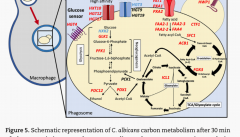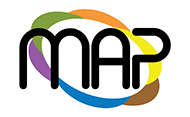
Teams
Paper: Métabolisme précoce du carbone et pathogénicité chez Candida albicans
Laurian R, Jacot-des-Combes C, Bastian F, Dementhon K, Cotton P. (2020) Carbon metabolism snapshot by ddPCR during the early step of Candida albicans phagocytosis by macrophages. Pathog Dis. 2020 Feb 1;78(1) During Candida macrophage interactions, phagocytosed yeast cells feed in order to grow, develop hyphae and escape. Through numerous proteomic and transcriptomic studies, two metabolic phases have been described. A shift to a starvation mode is generally identified as early as one-hour post phagocytosis, followed by a glycolytic growth mode after C. albicans escaped from the macrophage. Healthy macrophages contain low amounts of glucose. To determine if this carbon source was sensed and metabolized by the pathogen, we explored the transcription level of a delimited set of key genes expressed in C. albicans cells during phagocytosis by macrophages, at an early stage of the interaction. This analysis was performed using a technical digital droplet PCR approach to quantify reliably the expression of carbon metabolic genes after 30 min of phagocytosis. Our data confirm the technique of digital droplet PCR for the detection of C. albicans transcripts using cells recovered after a short period of phagocytosis. At this stage, carbon metabolism is clearly oriented towards the use of alternative sources. However, the activation of high-affinity glucose transport system suggests that the low amount of glucose initially present in the macrophages is detected by the pathogen.

